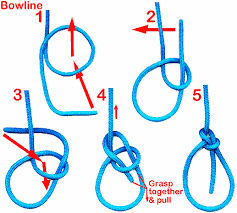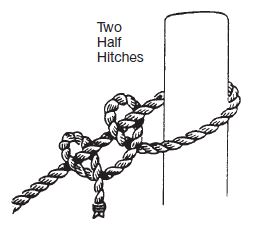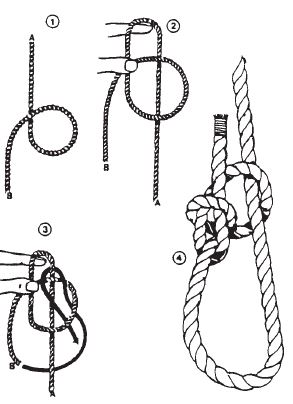
Fiber rope is a commonly used tool which has many applications in daily hoisting and rigging operations.
Readily available in a wide variety of synthetic and natural fiber materials, these ropes may be used as
- slings for hoisting materials.
- hand lines for lifting light loads.
- taglines for helping to guide and control loads.
There are countless situations where the rigger will be required to tie a safe and reliable knot or hitch in a fiber rope as part of the rigging operation. Fastening a hook, making eyes for slings, and tying on a tagline are a few of these situations.
This section addresses the correct selection, inspection, and use of fiber rope for hoisting and rigging operations. It also explains how to tie several knots and hitches.
Contents [hide]
Characteristics:
The fibers in these ropes are either natural or synthetic. Natural fiber ropes should be used cautiously for rigging since their strength is more variable than that of synthetic fiber ropes and they are much more subject to deterioration from rot, mildew, and chemicals.
Polypropylene:
Is the most common fiber rope used in rigging. It floats but does not absorb water. It stretches less than other synthetic fibers such as nylon. It is affected, however, by the ultraviolet rays in sunlight and should not be left outside for long periods. It also softens with heat and is not recommended for work involving exposure to high heat.
Nylon:
This fiber is remarkable for its strength. A nylon rope is considerably stronger than the same size and construction of polypropylene rope. But nylon stretches and hence is not used much for rigging. It is also more expensive, loses strength when wet, and has low resistance to acids.
Polyester:
This ropes are stronger than polypropylene but not so strong as nylon.They have good resistance to acids, alkalies, and abrasion; do not stretch as much as nylon; resist degradation from ultraviolet rays; and don’t soften in heat.
All fiber ropes conduct electricity when wet. When dry, however, polypropylene and polyester have much better insulating properties than nylon.
Inspection:
Inspect fiber rope regularly and before each use. Any estimate of its capacity should be based on the portion of rope showing the most deterioration.
Check first for external wear and cuts, variations in the size and shape of strands, discoloration, and the elasticity or “life” remaining in the rope.
Untwist the strands without kinking or distorting them. The inside of the rope should be as bright and clean as when it was new. Check for broken yarns, excessively loose strands and yarns, or an accumulation of powdery dust, which indicates excessive internal wear between strands as the rope is flexed back and forth in use.
If the inside of the rope is dirty, if strands have started to unlay, or if the rope has lost life & elasticity, do not use it for hoisting.
Check for distortion in hardware. If thimbles are loose in the eyes, size the eye to tighten the thimble (Figure 2.1). Ensure that all splices are in good condition and all tucks are done up (Figure 2.2).
(Figure 1.1) (Figure 1.2)
Working Load Limit:![]()
The maximum force that you should load a component is the working load limit (WLL). The WLL incorporates a safety factor (SF). The SF provides additional protection above the manufacturer’s design factor (DF). The design factor is the safety factor to which the manufacturer builds. The SF and DF do not provide added capacity. You must never exceed the WLL.
- Let’s calculate the WLL of a chain or gin wheel rated at 1000 pounds with a manufacturer’s DF of 3.
Note: Section 172 (1) (d) of the Construction Regulation requires a SF of 5.
This requirement is greater than our DF, so the capacity must be reduced accordingly.
WLL = 1000 pounds (rated capacity) x 3 (DF) / 5 (SF)
WLL = 600 pounds
In this example, the chain or gin wheel has a stamped capacity of 1000 pounds, but, in compliance with the Construction Regulation, it can safely lift a maximum capacity of 600 pounds.
Fiber Rope Selection:
Select the size and type of rope to use based on manufacturer’s information; conditions of use; and the degree of risk to life, limb, and property. The WLL of fiber rope is determined by multiplying the working load (WL) by the SF. The minimum breaking strength (MBS) is the force at which a new rope will break.
The manufacturer’s DF provides a layer of safety that has been determined by the manufacturer.
The SF, if greater than the DF, adds an additional layer of safety to meet the requirements of users and regulators. Together, these added layers of safety provide protection above the MBS to account for reduced capacity due to
- wear, broken fibers, broken yarns, age
- variations in construction size and quality
- shock loads
- minor inaccuracies in load weight calculations
- variances in strength caused by wetness, mildew, and degradation
- yarns weakened by ground-in or other abrasive contaminants.
If you notice rope that is defective or damaged, cut it up to prevent it from being used for hoisting.
Let’s calculate the WLL of a rope to lift a WL of 250 pounds.
Note: Section 172 (1) (d) of the Construction Regulation requires a minimum SF of 5.
For more critical lifts that could risk life, limb, or property, a SF of 10 to 15 may be necessary.
WLL = 250 pounds (WL) x 5 (SF)
WLL = 1,250 pounds
In this example, to meet the WLL you must use a rope with an MBS of 1,250 to hoist or lower a WL of 250 pounds. See manufacturers’ specifications to select the appropriate type of rope.
Care:
- To unwind a new coil of fiber rope, lay it flat with the inside end closest to the floor. Pull the inside end up through the coil and unwind counterclockwise.
- After use, recoil the rope clockwise. Keep looping the rope over your left arm until only about 15
feet remain. Start about a foot from the top of the coil and wrap the rope about six times around the loops. Then use your left hand to pull the bight back through the loops and tie with a couple of half hitches to keep the loops from uncoiling ( Figure 2.5).
( Figure 1.3)
- Remove kinks carefully. Never try to pull them straight. This will severely damage the rope andreduce its strength.
- When a fibre rope is cut, the ends must be bound or whipped to keep the strands from untwisting. Figure 2.4 shows the right way to do this.
Figure 1.4
Storage:
- Store fiber ropes in a dry cool room with good air circulation – temperature 10-21°C (50-70°F) humidity 40-60%.
- Hang fiber ropes in loose coils on large diameter wooden pegs well above the floor (Figure 2.5).
(Figure 1.5)
- Protect fiber ropes from weather, dampness, and sunlight. Keep them away from exhaust gases, chemical fumes, boilers, radiators, steam pipes, and other heat sources.
- Let fiber ropes dry before storing them. Moisture hastens rot and causes rope to kink easily. Let a frozen rope thaw completely before you handle it. Otherwise fibers can break. Let wet or frozen rope dry naturally.
- Wash dirty ropes in clean cool water and hang to dry.
Use:
• Never overload a rope. Apply the design factor of 5 (10 for ropes used to support or hoist personnel). Then make further allowances for the rope’s age and condition.
• Never drag a rope along the ground. Abrasive action will wear, cut, and fill the outside surfaces with grit.
• Never drag a rope over rough or sharp edges or across itself. Use softeners to protect rope at the sharp comers and edges of a load.
• Avoid all but straight line pulls with fiber rope. Bends interfere with stress distribution in fibers.
• Always use thimbles in rope eyes. Thimbles cut down on wear and stress.
• Keep sling angles at more than 45°. Lower angles can dramatically increase the load on each leg (Figure 1.6). The same is true with wire rope slings.
• Never use fiber rope near welding or flame cutting. Sparks and molten metal can cut through therope or set it on fire.
• Keep fiber rope away from high heat. Don’t leave it unnecessarily exposed to strong sunlight, which weakens and degrades the rope.
• Never couple left-lay rope to right-lay.
• When coupling wire and fiber ropes, always use metal thimbles in both eyes to keep the wire rope from cutting the fiber rope.
• Make sure that fiber rope used with tackle is the right size for the sheaves. Sheaves should have diameters at least six – preferably ten – times greater than the rope diameter.
(Figure 1.6)
Knots:
Wherever practical, avoid tying knots in rope. Knots, bends, and hitches reduce rope strength considerably. Just how much depends on the knot and how it is applied. Use a spliced end with a hook or other standard rigging hardware such as slings and shackles to attach ropes to loads.
In some cases, however, knots are more practical and efficient than other rigging methods, as for lifting and lowering tools or light material.
For knot tying, a rope is considered to have three parts (Figure 1.7).
(Figure 1.7)
The end is where you tie the knot. The standing part is inactive. The bight is in between.
Following the right sequence is essential in tying knots. Equally important is the direction the end is to take and whether it goes over, under, or around other parts of the rope.
There are overhand loops, underhand loops, and turns (Figure 1.8).
Overhand Loop Underhand Loop Turn
WARNING – When tying knots, always follow the directions over and under precisely. If one part of the rope must go under another, do it that way. Otherwise an entirely different knot – or no knot at all – will result.
Once knots are tied, they should be drawn up slowly and carefully to make sure that sections tighten evenly and stay in proper position.
Bowline:
Never jams or slips when properly tied. A universal knot if properly tied and untied. Two interlocking bowlines can be used to join two ropes together. Single bowlines can be used for hoisting or hitching directly around a ring.
Bowline on the Bight
Used to tie a bowline in the middle of a line or to make a set of double-leg spreaders for lifting pipe.
Pipe Hitch:
Reef or Square Knot:
Can be used for tying two ropes of the same diameter together. It is unsuitable for wet or slippery ropes and should be used with caution since it unties easily when either free end is jerked. Both live and dead ends of the rope must come out of the loops at the same side.
Two Half Hitches:
Two half hitches, which can be quickly tied, are reliable and can be put to almost any general use.
 Running Bowline:
Running Bowline:
The running bowline is mainly used for hanging objects with ropes of different diameters. The weight of the object determines the tension necessary for the knot to grip.
Make an overhand loop with the end of the rope held toward you
(1). Hold the loop with your thumb and fingers and bring the standing part of the rope back so that it lies behind the loop
(2). Take the end of the rope in behind the standing part, bring it up, and feed it through the loop
(3). Pass it behind the standing part at the top of the loop and bring it back down through the loop.
Figure-Eight Knot:
This knot is generally tied at the end of a rope to temporarily prevent the strands from unlaying.
The figure-eight knot can be tied simply and quickly and will not jam as easily as the overhand knot.
It is also larger, stronger, and does not injure the rope fibers. The figure-eight knot is useful in preventing the end of a rope from slipping through a block or an eye.
To tie the figure-eight knot, make an underhand loop
(1). Bring the end around and over the standing part
(2). Pass the end under and then through the loop
(3). Draw up tight.
Figure Eight Knot
